What Is An Inverted Winger?
‘A moderniser of the game, through the use of mazy wingers who pass through the gaps between defenders to feed the strikers, as they seldom cross’—a statement used to describe the legendary Arsenal manager Herbert Chapman’s 1922 FA Cup-winning side, Huddersfield Town.
Chapman was a visionary and forward-thinking manager for his era, breaking away from the dogmatic belief of orthodox wingers who play to the side of their preferred foot.
Almost a century later, the inverted wingers still hold their value as key players who can change a game and unbalance an organised defence.
Consider Ballon d’Or winners of the modern era, Ronaldinho, Lionel Messi and Cristiano Ronaldo, or those of the past, Johan Cruyff and George Best all of whom played as inverted wingers in their prime.
This is not to say that playing with inverted wingers is superior to having orthodox wingers; a team’s system and style have a lot to do with determining what is best.
If you wanted to get crosses into the box from a pacey winger before the opposition had time to drop and get in their defensive shape, then perhaps the choice of an orthodox winger is best suited to this style of play.
Below we will look at the unique and somewhat overlooked advantages of playing with inverted wingers.
For example, inverted wingers oftentimes do not have to engage in, let alone beat opposition full-backs in a footrace to get success.
Also, in-swinging crosses that inverted wingers can provide have proven more deadly and effective in comparison to out-swinging crosses in open play; there are two simple reasons for this.
Firstly, the forwards meet the cross-connect with the ball closer to the goal versus the meeting point of an out-swinging cross which has to be delivered deeper to avoid being collected by the opposition goalkeeper.
Secondly, it is more difficult to defend these types of crosses: why?
Well, the goalkeeper has a more onerous task in having to read the out-to-in flight of the ball before deciding whether to compete in the air for it.
Similarly, for defenders, if the flight of the ball is high and to the back post, they have to move towards and face their own goal as they look to make contact with a defensive header—all the more difficult in comparison to executing a lofted defensive header away while facing up the field.
In the tactical analysis below we will delve deeper into some of the advantages as well as the required style of play that supports playing with inverted wingers.
1-v-1 and supporting full-backs
Consider the tactical picture of a right-footed winger playing from the left supported from behind by a left-footed left-back.
Should the winger carry the ball forward and turn to dribble inside he now is attacking the opposition full-back’s weak foot as well as creating space out wide for the supporting full-back to attack should he receive a pass.
In contrast, if the winger is left-footed and engages in a 1-v-1 with the opposition full-back, he is forced to try to beat the full-back on the outside in a footrace.
The option to pass inside at this moment is denied due to the screening position of the full-back.
Also, should the winger look to turn and play backwards to a supporting teammate, he has to turn facing the sideline to protect the ball, at which point he can easily be forced into making an error as well as losing sight of teammates and passing opportunities.
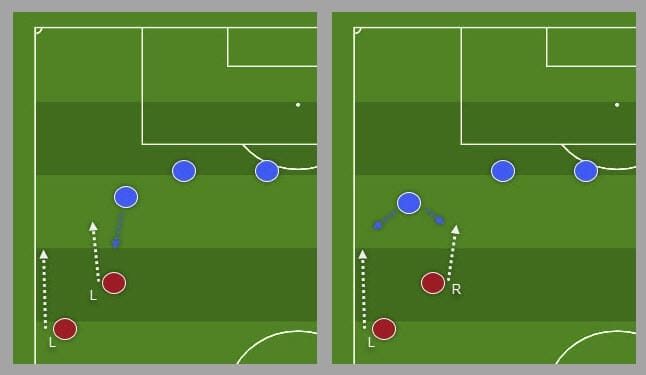
Above we see a tactical annotation of left and right foot comparisons on the same side of the field.
First, we see as both left-footers attack from the left side, meaning either player in possession is forced wide in their movement to protect the ball.
Also, if both are left-footed, they most likely will reduce each other’s space to play if they do not engage in a 1-v-1 against the full-back.
In contrast, having both a left and right-footed player on the same side offers more opportunities for both players in attack.
If the winger has the ball and moves inside, he creates space for his supporting full-back to overlap by engaging the opposition defender.
Similarly, other than multiple opportunities that become available by cutting inside the winger serves to unbalance the opposition’s defence by varying the ball centrally.
Attacking full-backs can also have their attacking potential reduced when playing behind a winger who plays on their natural side to their dominant foot.
This is because when the winger in front of the full-back receives the ball, he is more often than not forced into a footrace on the outside to protect the ball from the defender as well as to advance his team’s attack.
As a result, the supporting full-back has an unrealistic challenge to catch up with and bypass the winger on the outside to offer a forward outlet to progress the attack.
However, should an inverted winger step inside with the ball on his safe side he then serves to create space for an overlapping full-back in the channel.
The lack of urgency from the winger in these moments also allows time for the full-back to advance ahead of the play and become an attacking threat out wide on the same side.
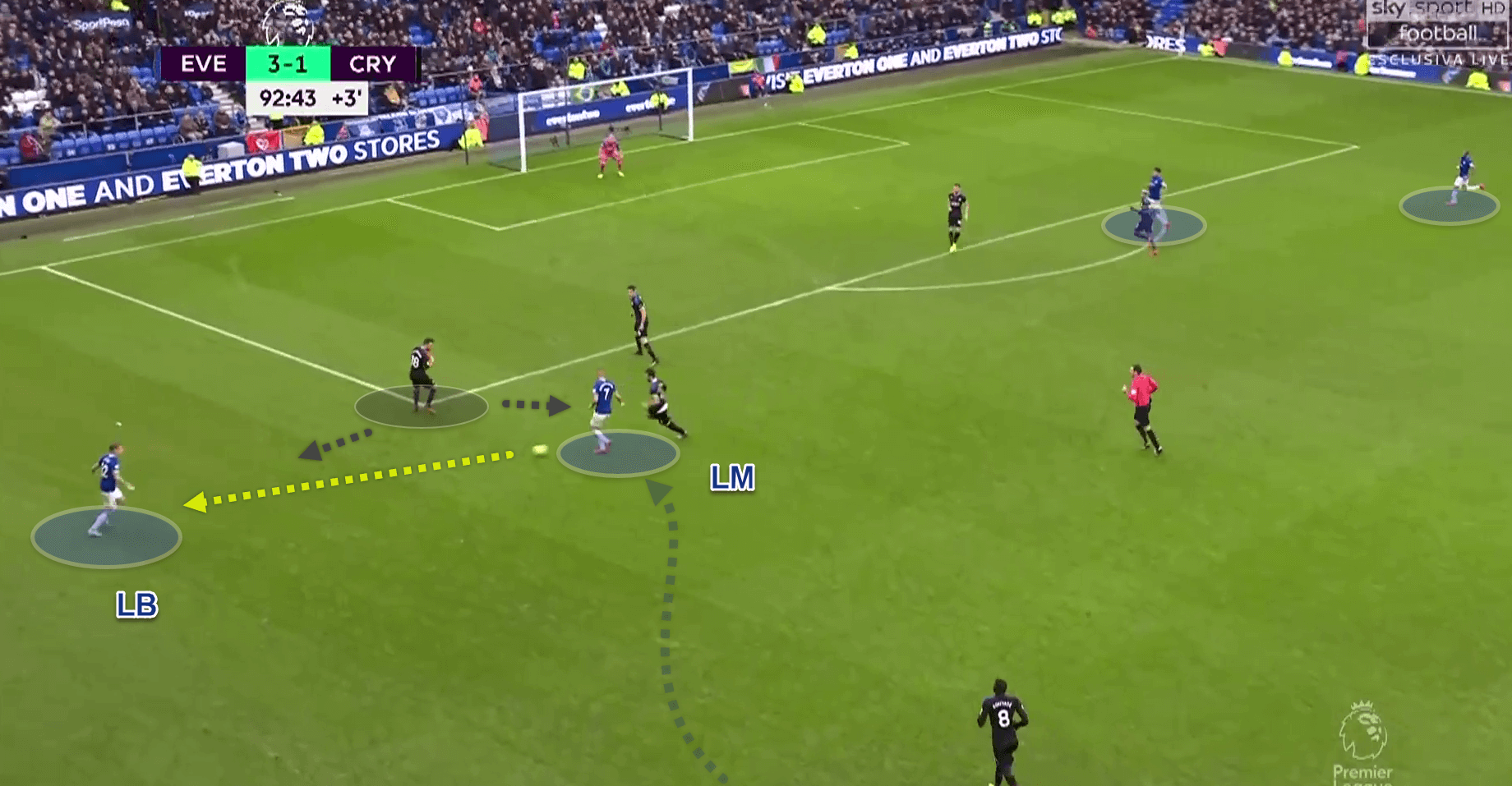
Above, we see an example of how an inverted winger serves the attacking potential of the full-back as well as to create unbalance in the opposition defence.
Richarlison, the ‘LM’ for Everton, has carried the ball forward significantly and at such a pace to allow the supporting ‘LB’ Lucas Digne to arrive in support of the attack.
Just as Richarlison is about to be tackled, he releases a pass to the ‘LB’ who has enough time and space to cross into the forwards entering the box.
The reason why the opposition full-back cannot press the ‘LM’ is because by doing so, he would release the space for the ‘LB’ to attack and enter the box in possession.
We see these moments created by teams who play with inverted wingers effectively.
Another important observation when it comes to inverting wingers cutting in for 1-v-1 duels is the opportunity for secondary success.
By which we mean a team winning, penalties, corners and free-kicks in dangerous positions as a result of successful dribbling from an inverted winger.
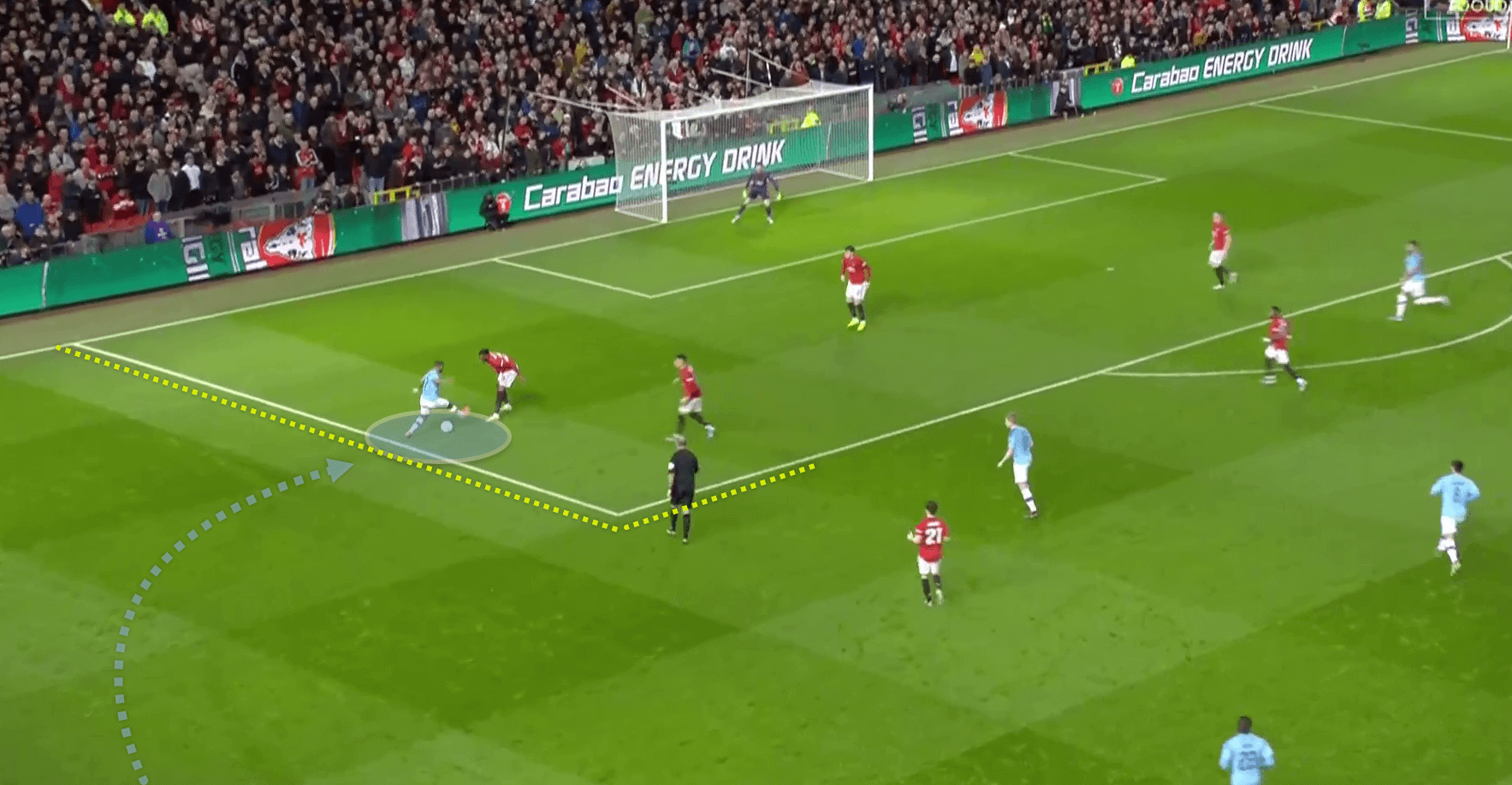
In the image above, Raheem Sterling receives the ball from as wide as the touchline, from a good first touch Sterling faces forward and dribbles slowly towards the box.
Due to the potential threat of the English winger and the lack of defensive support, the Manchester United full-back is apprehensive about committing to a challenge and subsequently offer Sterling the opportunity to enter the penalty area.
An area where it becomes even more dangerous to make a tackle.
The inverted winger and the full-back complement each other more than same-footed players on the same flank.
Consider only the more recent past, Arjen Robben and Philippe Lahm, Lionel Messi and Dani Alves or Robert Pires and Ashley Cole if you wish.
Wide players have more opportunity to show their worth in this relationship as it opens up the game and facilitates greater attacking potential from the winger and the supporting attacker from deep.
Penetration or switch
We know the value an inverted winger offers to the attacking potential of a supporting full-back.
However, by dribbling in-field between the midfield and the defensive lines of the opposition, more opportunities begin to open up for the winger to affect the game positively, let’s consider four options.
The first and more immediate chance to create a goal-scoring opportunity is the potential to give a penetrating pass to the striker moving into the blindspot of the deepest defender.
Second, as the opposition full-back stays with the ball-carrying winger, the space is created for the attacking full-back to affect the game.
Either by receiving a reverse pass from the winger or a pass circulated back around through the central midfielder.
Third, is an in-swinging cross to the back post to either the second striker or the opposite winger, depending on the formation of course.
Fourth and finally is the opportunity to switch the play quickly to the opponent’s weak side where they are unbalanced and unprepared to receive an attack.
This can happen by playing a crossfield pass to meet the forward run of the full-back or winger on the opposite side.
There is high value in this way of switching, as teams typically switch through their central players this usually means the play slows down momentarily as well as going backwards in most cases.
The speed and quicker timing of this switch can make all the difference in penetrating from the weak side of the opponent’s defence.
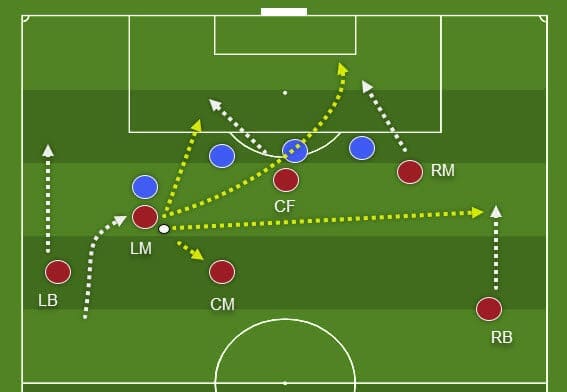
A visual representation of the four options stated above, let’s consider the opposition back four and how it affects their organisation in these moments.
The LM has carried the ball centrally on his safe side, the opportunities that can be made possible are first a penetrating pass to meet the diagonal run of the CF.
Secondly, there is the in-swinging cross to the back post to meet the run of the RM.
Third, is the Crossfield switch to meet the run of the attacking full-back on the opponent’s weak side.
As well as a short pass back to the CM who can re-circulate possession out wide for the attacking LB to dribble into the box or cross.
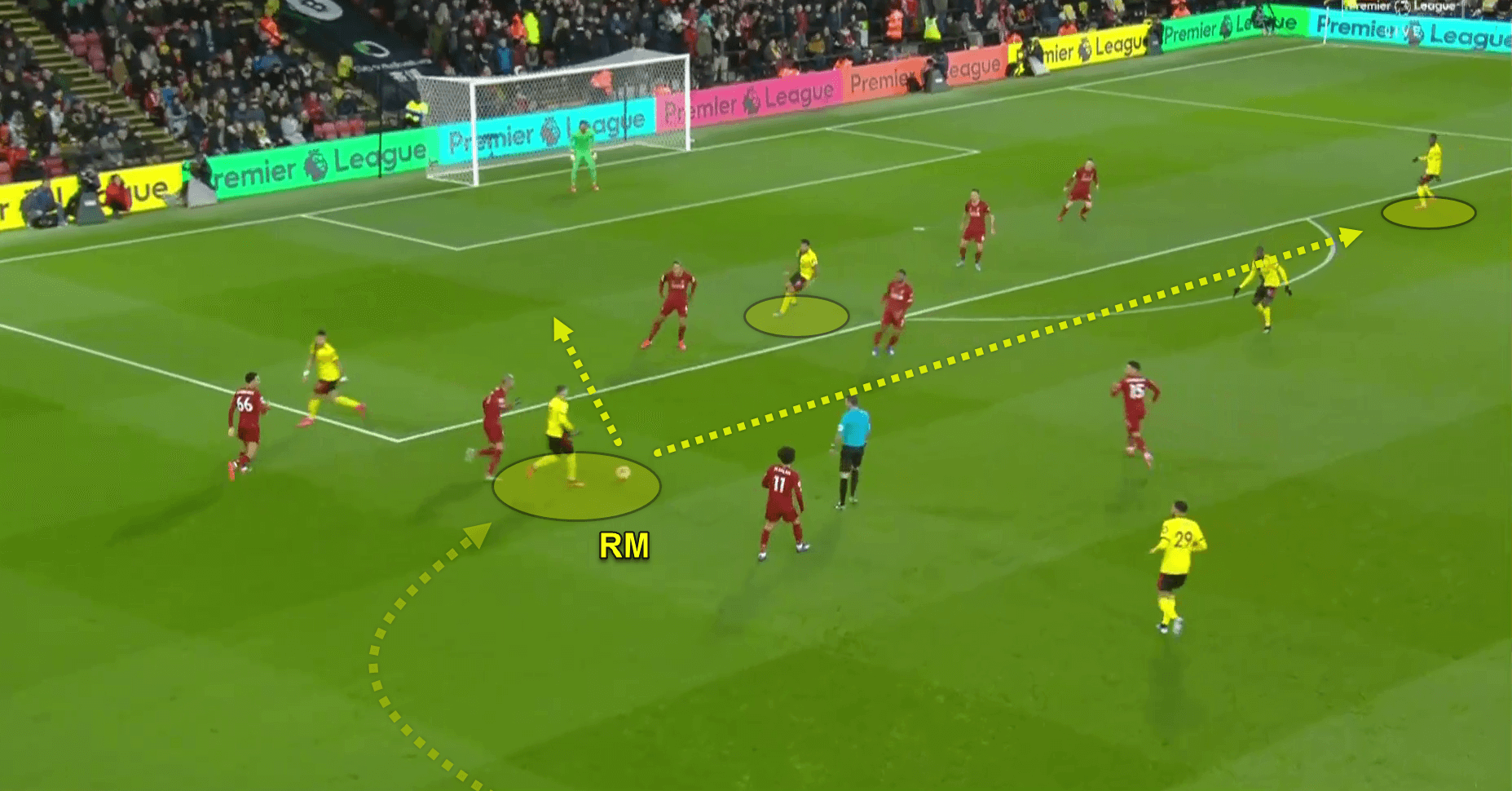
Above, we see a recent example from the Premier League game between Liverpool and Watford FC.
Gerard Deulofeu is playing as an inverted winger for Watford, a right-footer operating from the left.
At the moment Deulofeu carries the ball inside, after gaining a few yards centrally a few key options become available.
First, is the centre-forward Troy Deeney highlighted in yellow can make a blindside run behind Virgil Van Dijk the Liverpool centre-back to receive a penetrating pass and potentially score.
As Liverpool were compact and organised to receive an attack from their right, they are more exposed to a potential attack from the left temporarily if Deulofeu can switch the play to the right-midfielder early.
Deulofeu performed his role as an inverted winger exceptionally in this game as Liverpool’s right-back Trent Alexander-Arnold had one of his tougher tasks handling the pacey Watford winger in this matchup.
In-swinging crosses
Much like a winger’s role in a system of play, neither an in-swinging nor an out-swinging cross can be deemed superior.
It matters more how the team is set up to support and attack the cross that is delivered.
Both crossing types offer different values at different times, so in discovering the value of the in-swinging cross, we have to consider the factors that support its success.
A supporting full-back on the near side of the crosser helps create the angle for the cross by engaging the opposition defender, as well as the timing and movement to the back post by the forwards in the box.
As we mentioned in the beginning, the in-swinging cross means that the forward will most likely meet the ball closer to the goal than an out-swinging cross.
This is because the gradual curve of the cross comes at an out-to-in orientation to the goalkeeper.
Meaning the most opportune moment for the goalkeeper to claim the ball is when it is more threatening to the goal with a contentious forward.
Also for a forward attacking the cross at the back post means that the attacker has more of a view of both the ball and the goal before connecting, giving him a greater chance of success.
On the flip side for the defenders, the difficulty is that the defensive actions come when there is already backwards momentum while facing their own goal making it difficult to get a good defensive header back up the field.
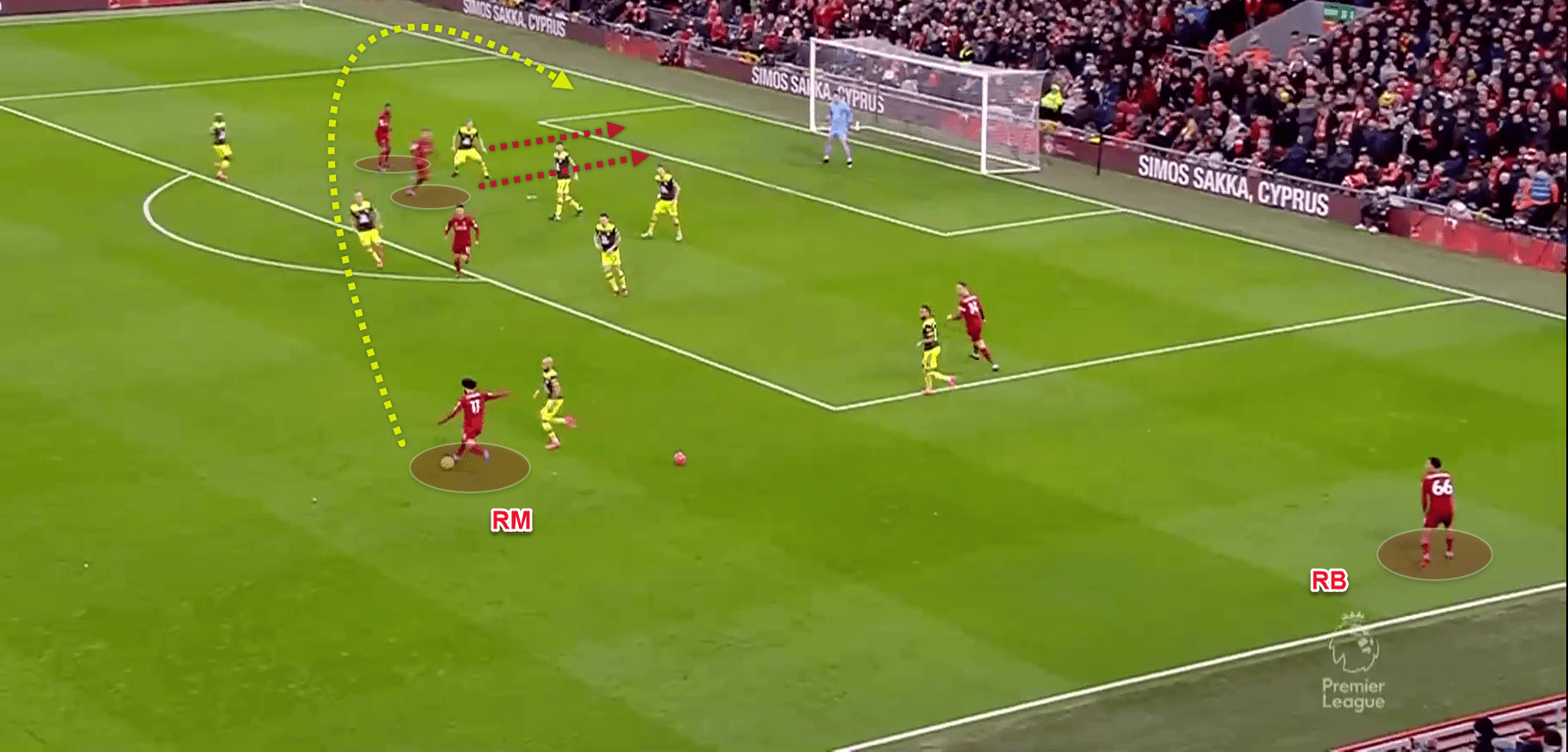
Above is an example of an in-swinging cross scenario, taken from the Premier League game between Liverpool and Southampton FC this past season.
Left-footer Mohammad Salah is about to deliver an in-swinging cross to the back post.
Observing the position of two key players in this moment that help facilitate the cross, Central midfielder Jordan Henderson makes a run from deep which engages one of the Southampton defenders in the corner of the box.
The overlapping full-back Alexander-Arnold helped delay the press to Salah from his high position while also offering himself as an alternative attacking outlet should the cross not be delivered.
As Salah delivers the cross notice the position of the two Liverpool forwards in the box at this time and the position they take up.
As we see, both Liverpool forwards are positioned a wide if not in a vertical line to the back post.
This position serves to help the forwards have the most optimum starting position such that If the cross is high to the back post, they are best placed to connect with the ball.
If the ball dips or falls short, then there is space to move forward still and attack the cross in flight.
The Southampton defenders have a difficult task in offering a good defensive header away as they will be facing their own goal if they successfully connect with the ball and defend their goal.
Open body finishing
Finally, we look at finishing.
Regardless of the position a player plays, the most optimum position a player can take up before shooting is one that offers them a full angle to the goal.
In contrast, consider a right-footer trying to score from a wide angle to the right of the goal.
When we playback in our memory, those low curled shots from Messi coming in off the right-hand side to finish down low in the bottom left.
Or a curled shot into the top right corner from the left side of the goal from a Thierry Henry highlight reel, these opportunities are only offered to a player with an open body shape and a full view of the goal.
Naturally inverted wingers who arrive in good goal-scoring positions, will be coming in at an angle to the goal which allows them to have the width of the goalmouth in their vision and body shape.
That is unless certain angles are compromised by opposing defenders; however, for the most optimum position for a successful finish, one cannot overlook the position offered to that of an inverted winger at sufficient range.
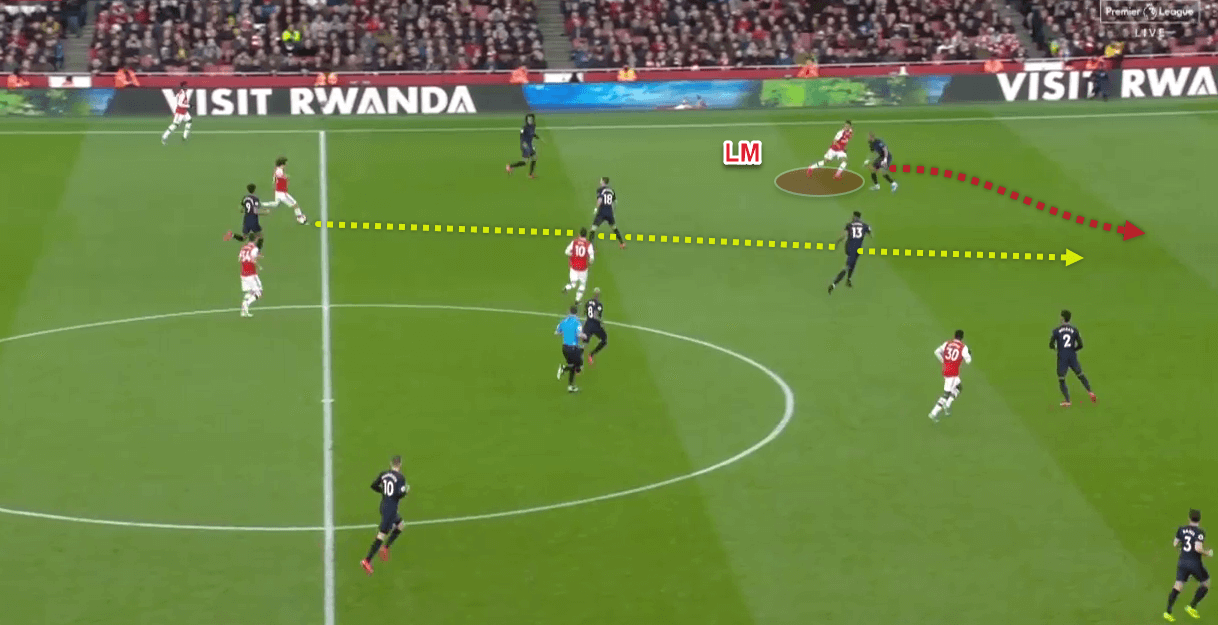
In the image above we see right-footed forward Pierre-Emerick Aubameyang who is playing as a left-winger for Arsenal makes a well-timed run to beat the offside trap and latch onto the through ball played by the Arsenal central midfielder.
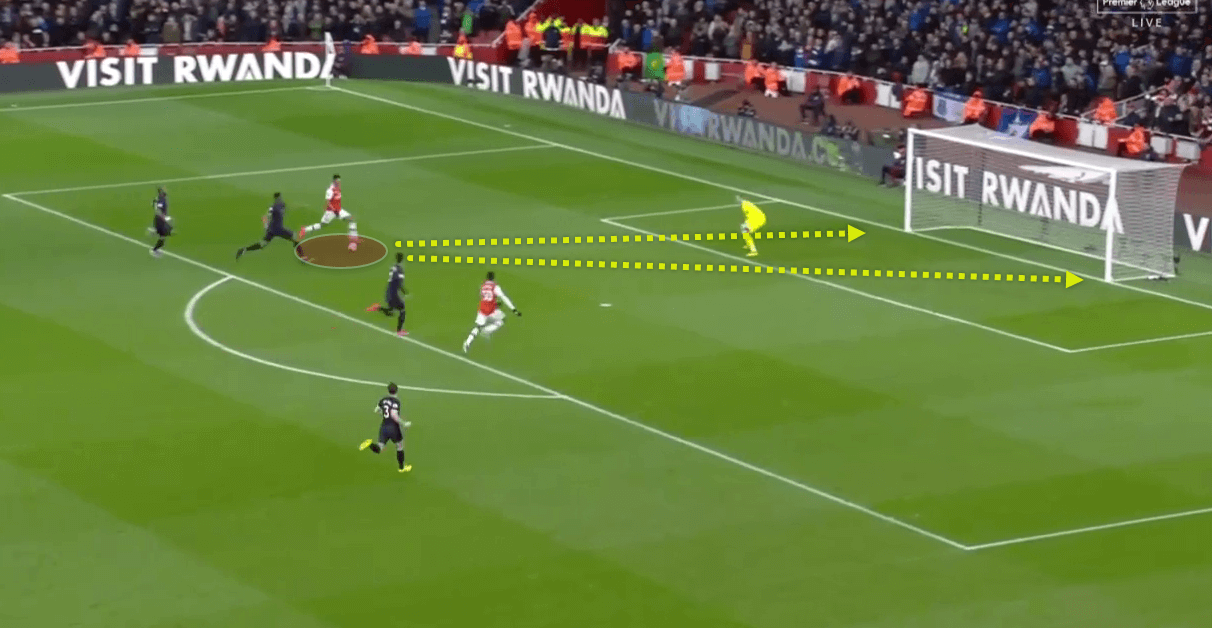
As Aubameyang takes a good first touch across the path of the recovering defender, he sets himself for a good chance to score on his second touch.
Notice the value that is offered to a right-footed player at this angle as Aubameyang has the view of the goal, the goalkeeper and the ability to finish on either side from this position.
Scenarios will change from moment to moment and game to game when you consider opportunities to score for an inverted winger.
However, considering the best opportunities for a successful finish inside or outside of the box a full view of the goal and an open body shape to finish at either side cannot be disputed as the most optimum for the best chance of getting success.
As mentioned earlier, when we look at previous Ballon d’Or winners in the modern era and the distant past, a lot of the game’s greatest players had their platform to perform as inverted wingers.
Final thoughts
If you are a fan, an analyst or a coach, I certainly hope there were some good takeaways for you in this article.
The role of inverted wingers is so rich in detail and has many advantage points that we can expand on for pages and pages; however, what is most important is the overarching points that were captured.
One thing I have noticed particularly in my time studying this position is that more than any other attacking position, the inverted winger seems to offer a platform for individual expression more than any other position in the game.
As an inverted winger, stepping in with the ball from this position means you have the goal and the passing options in your vision, and it is where some of the greatest players we have ever seen show their genius.
So many other positions have functions that allow little freedom for individual expression.
However, cutting in with the ball on the safe side to the defender and a view of the goal in sight has been like a blank canvas for the greats of the game.

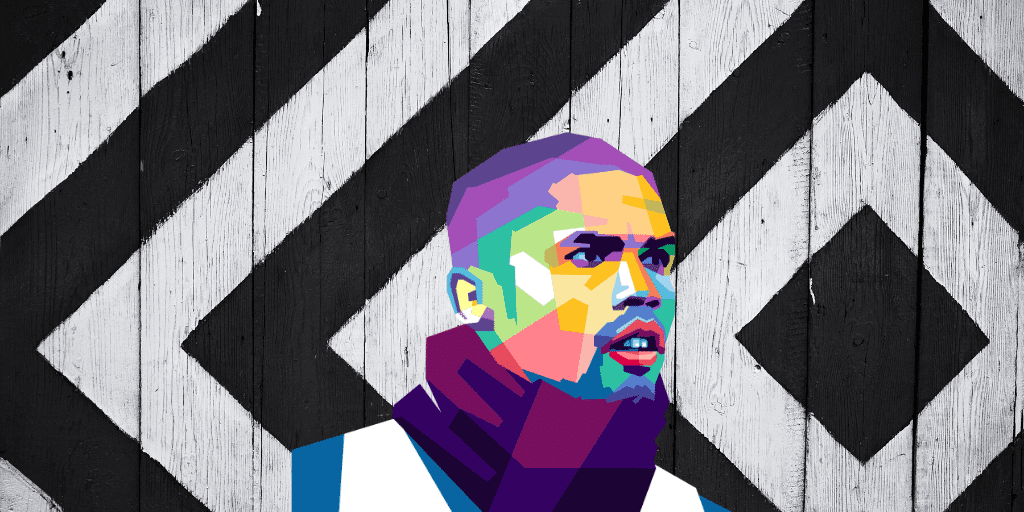


Comments